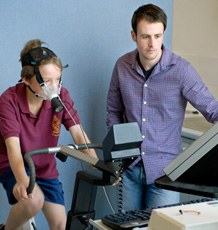
University home | Studying | Research | Business and community | Working here | Alumni and supporters | Our departments | Visiting us | About us
Exeter MR Research Centre
Paediatric Physiology Group
Collaborators


1- Exercise Physiology
| Title | Insights into developmental muscle metabolism through the use of 31P-magnetic resonance spectroscopy: a review. |
|---|---|
| Summary | (31)phosphorous-magnetic resonance spectroscopy ((31)P-MRS) has become an extremely valuable technique to investigate changes in muscle metabolism noninvasively and in vivo. The purpose of this article is to critically review how (31)P-MRS has contributed to current understanding of muscle metabolic function in healthy children and adolescents. In addition, an overview of the basic principles of (31)P-MRS and its application to the study of muscle metabolism is provided and discussed in relation to child-specific methodological concerns when using this technique. |
| References; | Barker, A.R. and Armstrong, N. (2010) Insights into developmental muscle metabolism through the use of 31P-magnetic resonance spectroscopy: a review. Pediatric Exercise Science. 22: 350-368. |
| Title | Age- and sex-related differences in muscle phosphocreatine and oxygenation kinetics during high-intensity exercise in adolescents and adults. |
|---|---|
| Summary | The aim of this investigation was to examine the adaptation of the muscle phosphates (e.g. phosphocreatine (PCr) and ADP) implicated in regulating oxidative phosphorylation, and oxygenation at the onset of high intensity exercise in children and adults. The hypotheses were threefold: primary PCr kinetics would be faster in children than adults; the amplitude of the PCr slow component would be attenuated in children; and the amplitude of the deoxyhaemoglobin/myoglobin (HHb) slow component would be reduced in children. Eleven children (5 girls, 6 boys, 13 +/- 1 years) and 11 adults (5 women, 6 men, 24 +/- 4 years) completed two to four constant work rate exercise tests within a 1.5 T MR scanner. Quadriceps muscle energetics during high intensity exercise were monitored using (31)P-MRS. Muscle oxygenation was monitored using near-infrared spectroscopy. The time constant for the PCr response was not significantly different in boys (31 +/- 10 s), girls (31 +/- 10 s), men (44 +/- 20 s) or women (29 +/- 14 s, main effects: age, p = 0.37, sex, p = 0.25). The amplitude of the PCr slow component relative to end-exercise PCr was not significantly different between children (23 +/- 23%) and adults (17 +/- 13%, p = 0.47). End-exercise [PCr] was significantly lower, and [ADP] higher, in females (18 +/- 4 mM and 53 +/- 16 microM) than males (23 +/- 4 mM, p = 0.02 and 37 +/- 11 microM, p = 0.02), but did not differ with age ([PCr]: p = 0.96, [ADP]: p = 0.72). The mean response time for muscle tissue deoxygenation was significantly faster in children (22 +/- 4 s) than adults (27 +/- 7 s, p = 0.01). The results of this study show that the control of oxidative metabolism at the onset of high intensity exercise is adult-like in 13-year-old children, but that matching of oxygen delivery to extraction is more precise in adults. |
| References; | Willcocks RJ, Williams CA, Barker AR, Fulford J, Armstrong N. (2010). Age- and sex-related differences in muscle phosphocreatine and oxygenation kinetics during high-intensity exercise in adolescents and adults. NMR Biomed. 23(6): 569-77. |
| Title | Quadriceps muscle energetics during incremental exercise in children and adults. |
|---|---|
| Summary | This study tested the hypothesis that the muscle metabolic responses of 9- to 12-yr-old children and young adults during incremental quadriceps exercise are dependent on age and sex. Fifteen boys, 18 girls, 8 men, and 8 women completed a quadriceps step-incremental test to exhaustion inside a magnetic resonance scanner for determination of the muscle metabolic responses using P-magnetic resonance spectroscopy. Quadriceps muscle mass was determined using magnetic resonance imaging scans enabling comparison of metabolic data at a normalized power output.The power output and the energetic state at the Pi/PCr and pH intracellular thresholds (IT) were independent of age and sex. The rate of change in Pi/PCr against power output after the ITPi/PCr (S2) was lower in boys (0.158 +/- 0.089) and girls (0.257 +/- 0.110) compared with men (0.401 +/- 0.114, P < 0.001) and women (0.391 +/- 0.133, P = 0.014), respectively, with sex differences present for children only (P = 0.003). Above the ITpH, S2 was more rapid in the men (-0.041 +/- 0.022, P = 0.003) and girls (-0.030 +/- 0.013, P = 0.011) compared with boys (-0.019 +/- 0.007), with no differences between the girls and the women (-0.035 +/- 0.015, P = 0.479). The increase in Pi/PCr at exhaustion was lower in boys (0.85 +/- 0.38) than that in men (1.86 +/- 0.65, P < 0.001) and in girls (1.78 +/- 1.25) than that in women (4.97 +/- 3.52, P = 0.003), with sex differences in both the child (P = 0.005) and the adult groups (P = 0.019). During moderate-intensity exercise, muscle metabolism appears adult-like in 9- to 12-yr-old children, although both age- and sex-related differences in the "anaerobic" energy turnover are present during high-intensity exercise. |
| References; | Barker AR, Welsman JR, Fulford J, Welford D, Armstrong N. (2010). Quadriceps muscle energetics during incremental exercise in children and adults. Med Sci Sports Exerc. 42(7):1303-13. |
| Title | Sex difference in peak oxygen uptake in prepubertal children. |
|---|---|
| Summary | Prepubertal boys' greater aerobic fitness (peak V O(2)) has been attributed to their larger lean body mass (LBM); this bestowing a greater heart size and consequent larger maximum cardiac output. No difference in peak arterio-venous (A-VO(2)) difference is thought to exist. However other work indicates that boys' aerobic fitness remains 5% higher even after controlling for differences in LBM. Consequently the purpose of this study was to investigate whether peak V O(2), heart size, peak cardiac output and peak A-VO(2) difference would be comparable between a group of boys and girls with a similar LBM. A group of 9 prepubertal boys and 9 prepubertal girls with a similar mean LBM (27.0+/-1.4 boys vs. 27.0+/-2.0 kg girls) were selected. Left ventricular mass (LVM) and end diastolic volume (LVEDV) were measured using cardiac magnetic resonance imaging. Peak V O(2) was determined on a cycle ergometer following an incremental exercise protocol to exhaustion, and cardiac output was recorded using thoracic bioimpedance. Boys' peak V O(2) (1.41+/-0.18 L min(-1) vs. 1.23+/-0.08 L min(-1)) and A-VO(2) difference (14.8+/-2.1 mL 100mL(-1) vs. 12.6+/-1.6 mL 100mL(-1)) were significantly (p<0.05) higher than girls' values, but there were no significant sex differences in peak cardiac output (10.0+/-1.4 L min(-1) vs. 9.9+/-1.40 L min(-1)), LVM (97+/-13g vs. 93+/-20g) or LVEDV (77+/-8 mL vs. 70+/-13 mL). Central factors of heart size and peak cardiac output are proportional to the LBM of the individual and sex independent. Sex differences in peripheral factors such as muscle fibre type profile, may affect A-VO(2) difference and underlie prepubertal boys' higher peak V O(2). |
| References; | Winsley, R.J., Fulford, J., Roberts, A.C., Welsman, J.R.,Armstrong, N. (2009). Sex difference in peak oxygen uptake in prepubertal children. Journal of Science and Medicine in Sport, 12: 647-51. |
| Title | Muscle phosphocreatine kinetics in children and adults at the onset and offset of moderate-intensity exercise. |
|---|---|
| Summary | The splitting of muscle phosphocreatine (PCr) plays an integral role in the regulation of muscle O2 utilization during a "step" change in metabolic rate. This study tested the hypothesis that the kinetics of muscle PCr would be faster in children compared with adults both at the onset and offset of moderate-intensity exercise, in concert with the previous demonstration of faster phase II pulmonary O2 uptake kinetics in children. Eighteen peri-pubertal children (8 boys, 10 girls) and 16 adults (8 men, 8 women) completed repeated constant work-rate exercise transitions corresponding to 80% of the Pi/PCr intracellular threshold. The changes in quadriceps [PCr], [Pi], [ADP], and pH were determined every 6 s using 31P-magnetic resonance spectroscopy. No significant (P>0.05) age- or sex-related differences were found in the PCr kinetic time constant at the onset (boys, 21+/-4 s; girls, 24+/-5 s; men, 26+/-9 s; women, 24+/-7 s) or offset (boys, 26+/-5 s; girls, 29+/-7 s; men, 23+/-9 s; women 29+/-7 s) of exercise. Likewise, the estimated theoretical maximal rate of oxidative phosphorylation (Qmax) was independent of age and sex (boys, 1.39+/-0.20 mM/s; girls, 1.32+/-0.32 mM/s; men, 2.36+/-1.18 mM/s; women, 1.51+/-0.53 mM/s). These results are consistent with the notion that the putative phosphate-linked regulation of muscle O2 utilization is fully mature in peri-pubertal children, which may be attributable to a comparable capacity for mitochondrial oxidative phosphorylation in child and adult muscle. |
| References; | Barker, A.R., Welsman, J.R., Fulford, J., Welford, D., Armstrong, N. (2008). Muscle phosphocreatine kinetics in children and adults at the onset and offset of moderate-intensity exercise. Journal of Applied Physiology, 105: 446-456. |
| Title | Muscle phosphocreatine and pulmonary oxygen uptake kinetics in children at the onset and offset of moderate intensity exercise. |
|---|---|
| Summary | To further understand the mechanism(s) explaining the faster pulmonary oxygen uptake (p(VO)(2)) kinetics found in children compared to adults, this study examined whether the phase II p(VO)(2) kinetics in children are mechanistically linked to the dynamics of intramuscular PCr, which is known to play a principal role in controlling mitochondrial oxidative phosphorylation during metabolic transitions. On separate days, 18 children completed repeated bouts of moderate intensity constant work-rate exercise for determination of (1) PCr changes every 6 s during prone quadriceps exercise using (31)P-magnetic resonance spectroscopy, and (2) breath by breath changes in p(VO)(2) during upright cycle ergometry. Only subjects (n = 12) with 95% confidence intervals <or=+/-7 s for all estimated time constants were considered for analysis. No differences were found between the PCr and phase II p(VO)(2) time constants at the onset (PCr 23 +/- 5 vs. p(VO)(2) 23 +/- 4 s, P = 1.000) or offset (PCr 28 +/- 5 vs. p(VO)(2) 29 +/- 5 s, P = 1.000) of exercise. The average difference between the PCr and phase II p(VO)(2) time constants was 4 +/- 4 s for the onset and offset responses. Pooling of the exercise onset and offset responses revealed a significant correlation between the PCr and p(VO)(2) time constants (r = 0.459, P = 0.024). The close kinetic coupling between the p(VO)(2) and PCr responses at the onset and offset of exercise in children is consistent with our current understanding of metabolic control and suggests that an age-related modulation of the putative phosphate linked controller(s) of mitochondrial oxidative phosphorylation may explain the faster p(VO)(2) kinetics found in children compared to adults. |
| References; | Barker, A.R., Welsman, J.R., Fulford, J., Welford, D., Williams, C.A., Armstrong, N. (2008). Muscle phosphocreatine and pulmonary oxygen uptake kinetics in children at the onset and offset of moderate intensity exercise. European Journal of Applied Physiology, 102: 727-738. |
| Title | Reliability of 31P-magnetic resonance spectroscopy during an exhaustive incremental exercise test in children. |
|---|---|
| Summary | This study examined the reliability of (31)P-magnetic resonance spectroscopy (MRS) to measure parameters of muscle metabolic function in children. On separate days, 14 children (7 boys and 7 girls) completed three knee-extensor incremental tests to exhaustion inside a whole-body scanner (1.5 T, Phillips). The dynamic changes in the ratio of inorganic phosphate to phosphocreatine (Pi/PCr) and intracellular muscle pH were resolved every 30 s. Using plots of Pi/PCr and pH against power output (W), intracellular thresholds (ITs) for each variable were determined using both subjective and objective procedures. The IT(Pi/PCr) and IT(pH) were observed subjectively in 93 and 81% of their respective plots, whereas the objective method identified the IT(Pi/PCr) in 88% of the plots. The IT(pH) was undetectable using the objective method. End exercise (END) END(Pi/PCr), END(pH), IT(Pi/PCr) and IT(pH) were examined using typical error statistics expressed as a % coefficient of variation (CV) across all three exercise tests. The CVs for the power output at the subjectively determined IT(Pi/PCr) and IT(pH) were 10.6 and 10.3%, respectively. Objective identification of the IT(Pi/PCr) had a CV of 16.3%. CVs for END(pH) and END(Pi/PCr) were 0.9 and 50.0%, respectively. MRS provides a valuable window into metabolic changes during exercise in children. During knee-extensor exercise to exhaustion, END(pH) and the subjectively determined IT(Pi/PCr) and IT(pH) demonstrate good reliability and thus stable measures for the future study of developmental metabolism. However, the objectively determined IT(Pi/PCr) and END(Pi/PCr) displayed poor reliability. |
| References; | Barker, A.R., Welsman, J.R., Welford, D., Fulford, J., Williams, C., Armstrong, N. (2006). Reliability of 31P-magnetic resonance spectroscopy during an exhaustive incremental exercise test in children. European Journal of Applied Physiology, 98: 556-565. |
2- Structure and Function
| Title | Gastric emptying rate of young cyclists by magnetic resonance imaging: three case studies |
|---|---|
| Summary | Gastric emptying rate during exercise has been documented in adult athletes, but not in younger athletes because of the utilization of invasive techniques. However, magnetic resonance imaging (MRI) is a noninvasive alternative. The aim of this study was to pilot the sequencing of MRI to a typical fluid intake strategy, in order to assess the viability of the procedure. Therefore, we compared the gastric emptying rate of water and a carbohydrate drink in three well-trained 17-year-old cyclists using MRI. Each participant cycled 4 bouts of 15 minutes each at moderate intensity followed by a ~15-minute time trial. Water or carbohydrate drinks were distributed in amounts of 200–250 mL. After an initial baseline MRI scan, cyclists ingested the first drink, cycled 15 minutes, followed by an MRI scan to assess remaining gastric volume. This feeding-exercise-scanning protocol was repeated thereafter. Relative to the initial volume at the start of the time trial, 69% and 72% of water and carbohydrate emptied during the time trial. MRI appears to be a feasible technique to assess gastric emptying rates in youth cyclists. |
| References; | Montfort-Steiger, V., Williams, C.A., Armstrong, N. and Fulford, J. (2010). Gastric emptying rate of young cyclists by magnetic resonance imaging: three case studies. J Exerc Sci Fit. 8: 34-40 |
| Title | Aerobic fitness and visceral adipose tissue in children |
|---|---|
| Summary | To determine the relationship between aerobic fitness (peak VO2) and the volume of visceral adipose tissue (VAT) in children. Participants were 30 males (13.7+/-0.5 y) and 22 females (13.5+/-0.5 y). Peak VO2 was determined using a continuous, incremental treadmill protocol to exhaustion. Abdominal VAT volume was measured by magnetic resonance imaging using multiple slices from vertebral levels L1-L5. Subcutaneous body fat measure was calculated as the sum of seven skinfolds (sigma7SKF). Females had significantly (p < or = 0.05) more VAT than males (1035+/-717.3 vs 678.6+/-361.5 cm3); however, male peak VO2 was higher (215+/-34 vs 182+/-20 ml/kg(0.61)/min). VAT was significantly (p < or = 0.05) negatively correlated with peak VO2 in both males (r = - 0.43) and females (r = - 0.45). Subcutaneous body fatness was significantly correlated with VAT in both males (r = 0.74) and females (r = 0.72), and was the single strongest determinant of VAT. Aerobic fitness is significantly inversely related to VAT, but subcutaneous body fatness is the single strongest determinant of VAT in children aged 13-14 y. |
| References; | Winsley, R.J., Armstrong, N., Middlebrooke, A.R., Ramos-Ibanez, N., and Williams, C.A. (2006). Aerobic fitness and visceral adipose tissue in children. Acta Paediatr. 95: 1435-1438. |
| Title | Prediction of visceral adipose tissue using air displacement plethysmography in children. |
|---|---|
| Summary | To determine the ability of air displacement plethysmography (ADP) to predict visceral adipose tissue (VAT) volume in children. Fifty-five (33 boys/22 girls) white children 13 to 14 years old were studied. Anthropometric measures were collected for body mass, stature, BMI, and waist-to-hip ratio (WHR), and body fat percentage was estimated from triceps and subscapular skinfolds, bioelectrical impedance analysis, and ADP. VAT volume was determined using magnetic resonance imaging, using a multiple slice protocol at levels L1 to L5. Boys had significantly (p < or = 0.05) less VAT volume than girls [645.1 (360.5) cm(3) vs. 1035.8 (717.3) cm(3)]. ADP explained the greatest proportion of the variance in VAT volume compared with the other anthropometric measures. Multiple regression analysis indicated that VAT volume was best predicted by ADP body fat percentage in boys [r(2) = 0.81, SE of the estimate (SEE) = 160.1, SEE coefficient of variation = 25%] and by WHR and BMI in girls (r(2) = 0.80, SEE = 337.71, SEE coefficient of variation = 33%). Compared with the other anthropometric measures, ADP explains the greatest proportion of the variance in VAT volume in children 13 to 14 years old. For boys, ADP is the tool of choice to predict VAT volume, yet using the more simply collected measures of BMI and WHR is recommended for girls. However, large SE of the estimates remained, suggesting that if precision is needed, there is no surrogate for direct imaging of VAT. |
| References; | Winsley, R.J., Fulford, J., MacLeod, K.M., Ramos-Ibanez, N., Williams, C.A., Armstrong, N. (2005). Prediction of visceral adipose tissue using air displacement plethysmography in children. Obesity Research. 13: 2048-2051. |




